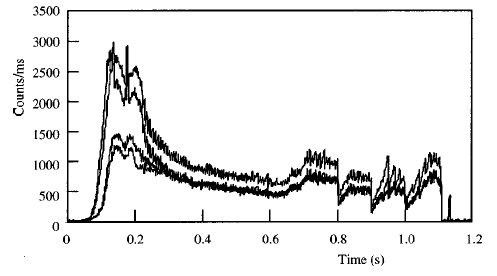
Using small pick-up pads (pixels) in the read-out plane, the detector can achieve unambiguous two-dimensional imaging of soft X-rays at rates up to 4 MHz/pixel. In development for plasma diagnostics at Tokamak fusion machine
(EURATOM-ENEA Frascati, INFN Pisa):
D. Pacella, G. Pizzicaroli, L.Gabellieri, M. Leigheb, R. Bellazzini, A. Brez, G. Gariano, L. Lantronico, N. Lumb, G. Spandre, M.M. Massai, S. Reale: Ultrafast soft x-ray two-dimensional plasma imaging system based on the Gas Electron Multiplier detector with pixel readout, Rev. Scient. Instrum. 72 (2001)1372 GET PAPER
Signal from 4 adjacent pixels of the GEM detector with a central line of sight and ohmic plasma; the peaks correspond to the injection of pellets (Frascati Tokamak):

With the same detector, two-dimensional time-resolved images of the plasma have been recorded at the National Spherical Tokamak Experiment (NSTX) at Princeton Plasma Physics Laboratory. The pictures show examples of X-ray intensity distribution in the plasma (sampling rate 1 kHz):
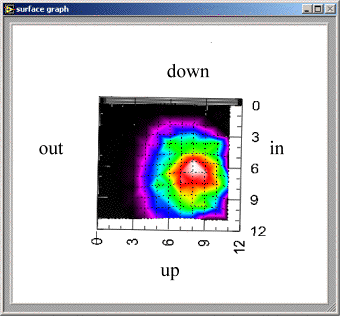
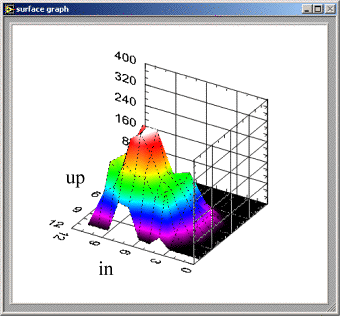
The time evolution of the plasma can be seen in the QuickTime movie (double-click to start). One can see that the interacting plasma rotates before dying away.
See also http://efrw01.frascati.enea.it/~leigheb/GEM/risult.htm
For more informsation, contact danilo.pacella@enea.it
SCINTILLATING GEMS
Inelastic processes that lead to the avalanche growth in proportional counters result also in copious emission of photons (fluorescence). This light can be exploited for detection. Devices incorporating one or more GEM and optimized for their light yield are being developed by several groups. On irradiation with an ionizing source (charged or neutral) electrons released in the sensitive volume are drifted into the multiplier(s). The flashes of light emitted in the avalanches are detected with a low noise solid state camera. Because of the linearity of response up to very high fluxes, and of the simplicity of the read-out hardware, imaging GEM detectors can find applications in high-rate medical diagnostics (portal imaging)
Development at LIP-Coimbra:
F.A.F. Fraga, L.M.S. Margato, S.T.G. Fetal, R. Ferreira Marques and A.J.P.L. Policarpo, IEEE Nucl. Sc. Symposium Lyon 2000 GET PAPER:
Schematics of the scintillating GEM detector:
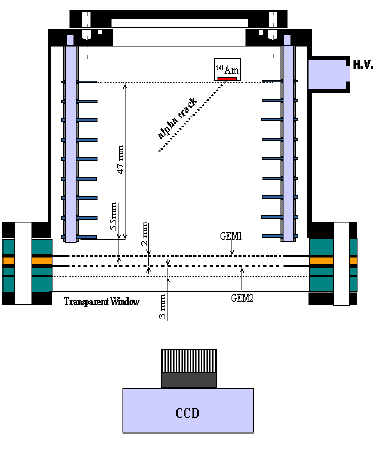
Individual alpha particle tracks visualized with the imaging GEM detector:
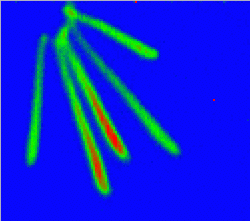
NEUTRON DETECTION
The same group is developing a neutron detector with a scintillating GEM coupled to a CCD readout. Neutrons are converted in a gas mixture of 3He and CF4, and the resulting proton and triton tracks detected optically:
F.A. F. Fraga L.M.S Margato, S.T.G. Fetal, M.M.F.R. Fraga, R. Ferreira-Marques, A.J.P.L. Policarpo, B. Guerard, A. Oed, G. Manzin, T. van Vuure: CCD readout of GEM based neutron sources, Paper presented at the Vienna Conf. on Instrumentation, Feb. 19-23, 2001 (Subm. to Nucl. Instrum. Methods) GET PAPER
The excellent linearity of response of a GEM-based imaging detector can be exploited for accurate mapping of the dose imparted during X-ray therapy . This method is developed by a group at KVI Groningen and TU Delft, The Netherlands:
T. van Vuure, C. van Eijk, F. Fraga, R. Hollander, High pressure GEM operation aiming at thermal neutron detection, IEEE Nucl. Science Symposium and Medical Imaging Conf., Lyon Oct. 15-20, 2000
J. H. Timmer, T.L. van Vuure, V. Bohm, C.W. van Eijk, J. de Haas nad J.M. Schippers, Vienna Conf. on Instrumentation, Feb. 19-23, 2001
Depth-dose curve (Bragg peak) measured with a scintillating double GEM on a proton beam:
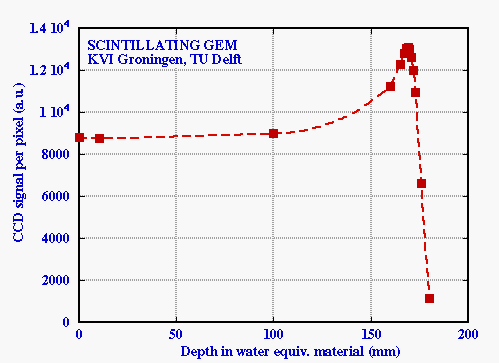
A group at Heidelberg University is developing a neutron detector (named CASCADE) using multiple GEM converters; see their WEB PAGES.
Schematics of the CASCADE neutron detector:
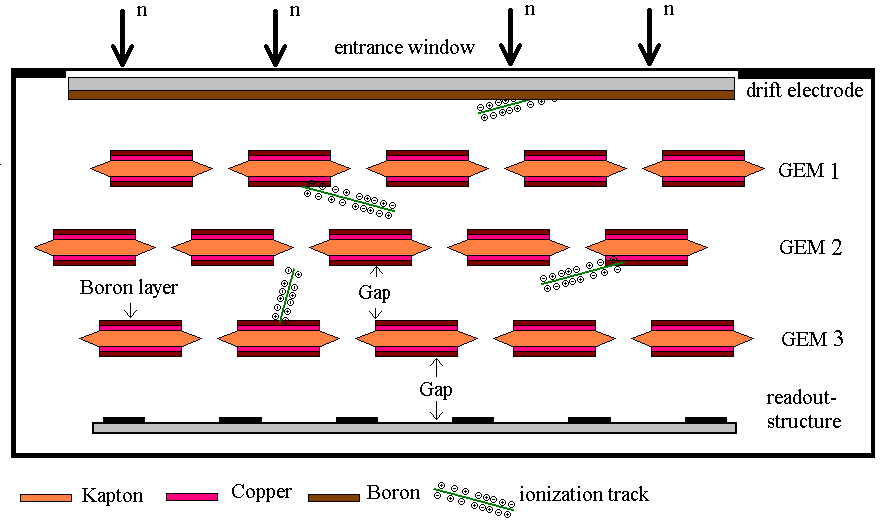
HIGH RATE GEM DETECTORS FOR PORTAL IMAGING
This work aims at developing a device capable of on-line control and verification of the radiation treatment of cancer patients. It consists of two consecutive detectors in the same gas vessel, one optimized for keV and the other for MeV photon detection. It is being developed by a groups at Karolinska Institute and Royal Institute of Technology, Stockholm.
A. Brahme, M. Danielsson, C. Iacobaeus, J. Ostling, V. Peskov, M. Wallmark, Nucl. Instrum. Methods A454(2000)136
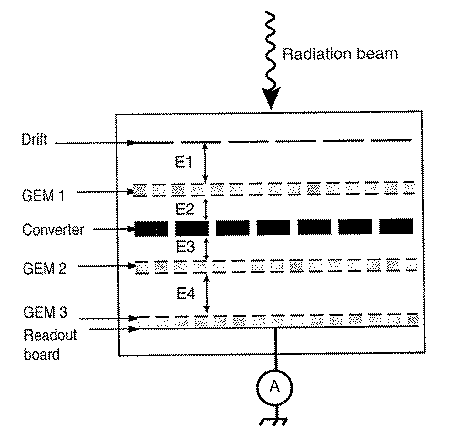
Contact anders.brahme@ki.se
DETECTION OF SINGLE PHOTOELECTRONS: GEM GAS PHOTOMULTIPLIER
The particular GEM structure with narrow, independend multiplying channels, and the opacity to photon and ion feedback permit to reach very high gains in pure noble gases and their mixtures.
Multiple GEM structures, with up to 4 cascaded multipliers, are being studied in view of the development of large area, position sensitive photomultipliers. Groups involved are at CERN, the Weizman Institute of Sciences, Rehovot and at the Budker Institute fro Nuclear Physics, Novosibirsk.
Example of gain measiured in various noble-gas mixtures:
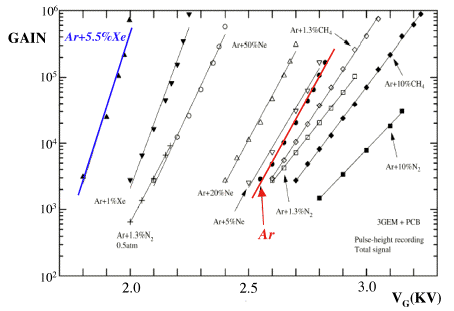
A. Bressan, A. Buzulutskov, L. Ropelewski, F. Sauli, and L. Shekhtman, High gain operation of GEM in pure argon. Nucl. Instrum. and Meth. A423 (1998) 119.
A. Breskin, A. Buzulutskov, R. Chechik, B.K. Singh, A. Bondar, L. Shekhtman, Sealed GEM photomultiplier with a CsI photocathode, Vienna Conf. on Instrumentation, Feb. 19-23, 2001. Subm. Nucl. Instrum. Methods GET PAPER
A. Buzulutskov, A. Breskin, R. Chechik. G. Garty, F. Sauli and L. Shekhtman, The GEM photomultiplier operated with noble gas mixtures, Nucl. Instr. and Meth. A 443(2000)164.
Both semi-transparent and reflective photocathodes have been tested: in the second case, the photocathode is deposited directly over the first GEM:
A quadruple GEM photon detector with the photocathode evaporated on the top face of the first GEM in a cascade:
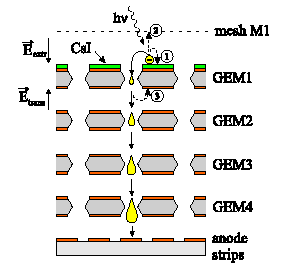
D. Mörmann, A. Breskin, R. Chechik, P. Cwetanski, B.K. Singh, A gas avalanche photomultiplier with a CsI-coated GEM, Subm. Nucl. Instrum. Methods GET PAPER
Link to the WIS Radiation Detector Laboratory
X-RAY POLARIMETER FOR ASTROPHYSICS
A single GEM detector with small pads readout provides good efficiency for detection of soft X-rays, and sufficient accuracy to measure the average angle of emission of the emitted photoelectron:

This provides information on the polarization of the X-ray source:

E. Costa, P. Soffitta, R. Bellazzini, A. Brez, N. Lumb, and G. Spandre, An efficient photoelectric X-ray polarimeter for the syudy of black holes and neutron stars, Nature 411 (2001) 662.